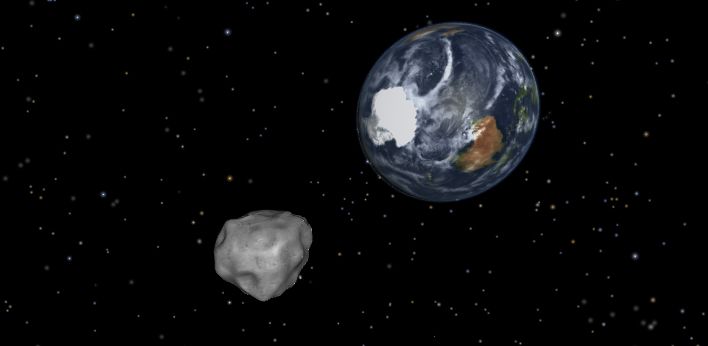Next Week's Asteroid Flyby Shows Earth is in 'Cosmic Shooting Gallery'

The people of Earth are not doing enough to protect their home planet from the threat of an asteroid impact, scientists said today (Feb. 5) as they track a space rock slated to make a close shave next week.
The asteroid due to pass exceptionally close to Earth on Feb. 15 — called 2012 DA14 — was discovered only last year by amateur astronomers with the help of a grant from a non-profit agency. While asteroid 2012 DA14 poses no risk of hitting Earth, there are likely hundreds of thousands more rocks like it out there, its discoverers said.
"We live in a cosmic shooting gallery and it's a reminder that we need to keep doing our work to find these things and to prevent the only preventable natural disaster, which is asteroid impact," said Bruce Betts, a planetary scientist at the Planetary Society, the non-profit space research and exploration organization that helped sponsor the discovery of asteroid 2012 DA14.
"We are not doing enough" to find potentially dangerous asteroids, Bruce told reporters today during a teleconference. "We're doing more than we were 15 years ago, and these surveys are helping out. We're discovering them faster. To be safe, we need a lot higher rate of discovery."
One person who's pitching in to help is Jaime Nomen, a dental surgeon by day, and an asteroid hunter by night. Nomen is part of the team at Spain’s La Sagra Observatory that discovered 2012 DA14 about a year ago. [Asteroid 2012 DA14's Flyby: Fact vs. Fiction (Video)]
Asteroid 2012 DA14 is about half the width of a football field (150 feet, or 45 meters), and will fly within 17,200 miles (27,700 kilometers) of our planet on Friday, Feb. 15, zooming closer to the planet than the ring of satellites in geosynchronous orbit.
Not long before the asteroid's February 2012 discovery, Nomen and his team won a Planetary Society-sponsored Shoemaker Near-Earth Object Grant that allowed them to upgrade the CCD camera on one of their telescopes, which boosted the number of images the team can snap of quick-moving objects.
Sign up for the Live Science daily newsletter now
Get the world’s most fascinating discoveries delivered straight to your inbox.
Projects like the La Sagra search can sometimes find asteroids that slipped through the cracks of the larger NASA-run surveys that are responsible for the majority of the near-Earth asteroid discoveries every year, Nomen said. Still, there are so many mid-range space rocks, such as 2012 DA14, and they move so quickly, that a major survey might look at a spot in the sky one day and not see anything, but the next day, an asteroid might be spotted there, he said.
"Those small objects could appear at any moment," Nomen said. "For sure there are many that remain undiscovered."
While Earth is safe from 2012 DA14, an asteroid that size would do a lot of damage if it did impact our planet. A similar-sized rock slammed into Tunguska, Siberia, in 1908, and flattened some 500,000 acres of forest over an area about the size of Tokyo.
And there's plenty more where that one came from.
"The objects are out there and eventually they will hit," Betts said. "It's not a question of whether we'll have catastrophic impacts, it's a question of when."
With some advance warning of an asteroid impact, on the scale of about 10 years, scientists have a number of strategies that could potentially be used to alter the path of a space rock on a collision course. But if such a threat was discovered just months or days ahead of time, the best we could do would likely be to evacuate the area, Nomen said.
NASA will hold another press teleconference on the approaching asteroid 2012 DA14 on Thursday (Feb. 7) at 2 p.m. EST (1900 GMT). Visit SPACE.com Thursday for complete coverage of that news event.
This story was provided by SPACE.com, a sister site to Live Science. You can follow SPACE.com assistant managing editor Clara Moskowitz on Twitter @ClaraMoskowitz. Follow SPACE.com on Twitter @Spacedotcom. We're also on Facebook & Google+.













